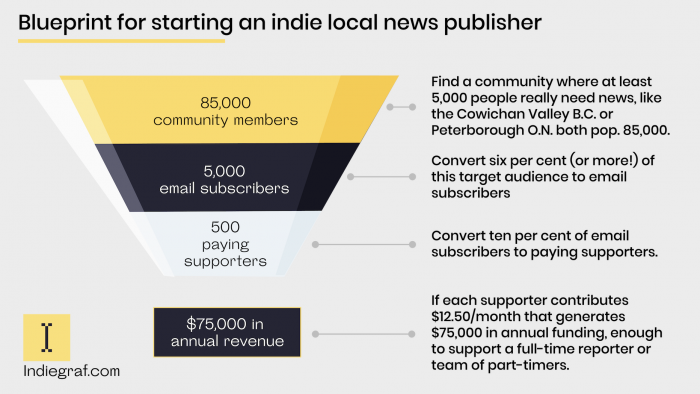
What would a newspaper chain look like if it were reimagined for a group of digital, subscriber-funded publications?
Indiegraf, a new network of independent local news outlets launching in Canada Wednesday, thinks it might have the answer. Founded by sisters Erin Millar and Caitlin Havlak of The Discourse, Indiegraf will provide publications with pooled resources — including technology and marketing staff — to launch or grow subscriber-based businesses. The network thinks of itself as “the tech and business engine” for entrepreneurial journalists who want to launch a digital news operation, but don’t have the resources to hire their own developers or wage extensive marketing campaigns.
In a post on Indiegraf’s new site, Millar wrote:
Built by news entrepreneurs for news entrepreneurs, we want Indiegraf to offer journalists starting their own news businesses the advantages of being part of a larger chain — access to capital, a proven model, technology, infrastructure to support their growth — without the burden of the big chains’ debt obligations, executive compensation, legacy business models and editorial directives.
The outlets will share marketing resources as well as common technology — including a customized WordPress system — and a developer. Unlike in a traditional newspaper chain, each publication will remain wholly independent. Each journalist-entrepreneur retains control over their editorial operations, owns their content and data, and can leave the network at any time.
With Indiegraf, Millar believes she has found a business model that will allow scrappy digital publications to devote the bulk of their resources to journalism rather than overhead. Millar cited Nieman Lab’s own Ken Doctor, who has written that “the print-based daily model — with presses, newsprint, trucks, big office buildings, and more to pay for — can only afford 12 to 20 percent on content.”“Here’s the bottom line,” Millar wrote. “In the traditional model, taking Doctor’s numbers, every dollar spent on producing journalism costs an extra $5 to $8.33 in infrastructure costs to get it to readers. In our model, every dollar spent on journalism costs only 33 cents on other stuff.”
The network received seed funding from Google News Initiative and Facebook’s Journalism Project as well as earlier support from The Inspirit Foundation. The network’s publishers will also receive advertising credits from the tech companies to help collect newsletter subscribers. “There are very few funders in Canada who are willing to invest in new innovation — including our government,” said Millar, referring to programs like the Local Journalism Initiative that have been criticized as favoring legacy newspapers over upstart digital operations. “We’re going to play with the partners who are willing to play, to be frank. There’s no strings attached.”
The financial support allows Indiegraf to offer the pooled resources to its first 10 partners at a steep discount. Eventually, Millar says the network will be supported by sharing in the revenue they raise for publications.
Indiegraf launches with seven independent outlets under its wing: IndigiNews, Peterborough Currents, La Converse, Spark YQL, The Discourse Nanaimo, The Discourse Cowichan, and Sun Peaks Independent News. The majority are brand new, having been launched since mid-March, and led by women. SPIN is the lone print newspaper of the group; the 17-year old publication pivoted to a digital subscription-based model for the first time amid COVID-19. Others, including the francophone “pop-up” La Converse, publish through an email newsletter and social media.
The Indiegraf model was born out of Millar and Havlak’s own research and experimentation building community-funded journalism at The Discourse over the past five years as well as a nine-week Independent News Challenge where the co-founders “kicked the tires” on the idea. The challenge results — which included one publication raising $34,000 in its first reader-funded drive and another gaining 2,000 email subscribers — was enough to convince the cofounders that they’d found “a promising and replicable approach to delivering quality local journalism sustainably.”
At a minimum, Millar believes each publication will be able to support one journalist doing community journalism like “showing up at City Hall” with 5,000 email subscribers. The back-of-the-envelope math relies on 10 percent of email subscribers converting to paid subscribers at $150/year.

The community response to The Discourse Cowichan, a local news organization led by reporter Jacqueline Ronson that provides a rural area of Vancouver Island with stories through email and social media, also shaped the network. Regular reader interviews, social media outreach, testing, and close collaboration with Ronson allowed Millar to tailor marketing efforts to readers in Cowichan from afar. As Millar wrote:
Its revenue model works like this: The Discourse Cowichan provides its journalism for free and invites its most engaged readers to become financial supporters. In the past eight months, its audience and reader-revenue has grown by over 500 per cent. That growth, combined with small grants and sponsorships, enabled us to grow it to two full-time reporters, a part-time writer and occasional interns and freelancers, supported by our Vancouver-based team.
Here’s the secret to how Jacqueline’s team delivers journalism valuable enough people will pay for it: they ask their community what to cover. They don’t report on *everything* (no local sports and little crime reporting). They don’t crank out surface-level stories in pursuit of traffic. They only dig into stories their community really needs and don’t waste money on anything else.
As it turns out, people will pay for that.
Indiegraf makes its debut amid a deepening sense of urgency in local news. Pressures on traditional news organizations, dependent on advertising revenue, have mounted thanks to the economic fallout from the coronavirus and Millar described an “apocalypse” in Canadian local news. She says viewing the pandemic as a once-in-a-generation opportunity has motivated her newly formed team.
“Fifty Canadian publications have folded due to the coronavirus in the last eight weeks,” Millar said. “For context, 215 shut in the previous decade, which everybody called a crisis, and now 25 percent of that happened in two months.” (According to the Canadian COVID-19 Media Impact Mapping Project, another 29 outlets have canceled some — or all — print editions and more than 2,000 news staffers have been laid off.)
“I’m someone very motivated by equity. This does not impact all Canadians equally. We know this sets back efforts to diversify newsrooms. We know that the communities most vulnerable to COVID are also those who are going to be most likely to lose their local news,” Millar said. “The situation really lit a fire under us to move quickly and cut through some of the bullshit.”
Millar hopes to end the year with 10 self-sustaining news organizations in Canada. She said journalists they’ve spoken with have been largely receptive to Indiegraf’s network idea. “It’s not that we’re some kind of geniuses,” Millar said. “It’s just that we’re doing something, and I think people are hungry for that, particularly at this moment.”
There are plans to add a set of independent American outlets, too, but Millar stressed that Indiegraf would rather “go deep” with a small number of publications and securely fund each newsroom before expanding.
“That’s a big part of this — keep it lean and scrappy, and then grow from there,” Millar said. “In the longer term, we want to see this be a model that any entrepreneurial journalist can easily access what they need to get up and running, and that could help us restore in-depth, quality journalism in the hundreds of communities that need it across North America.”